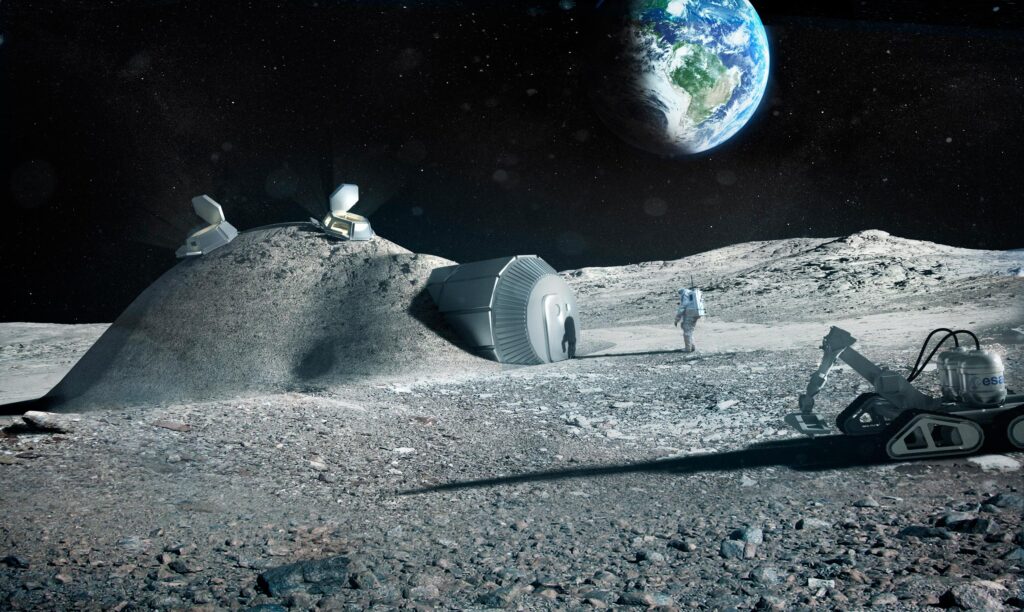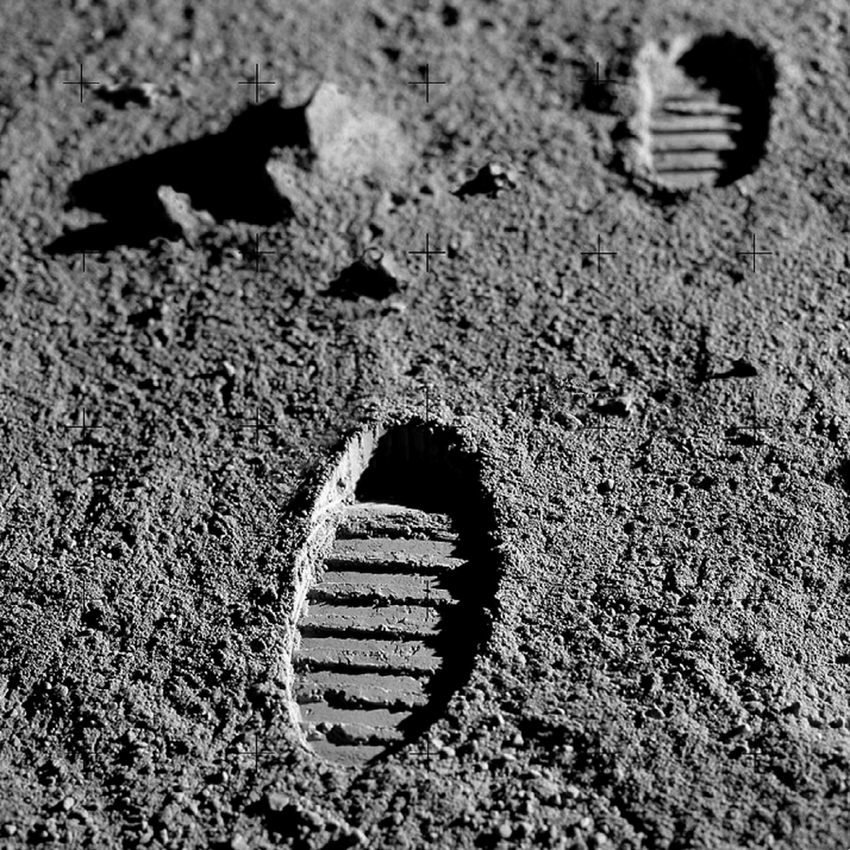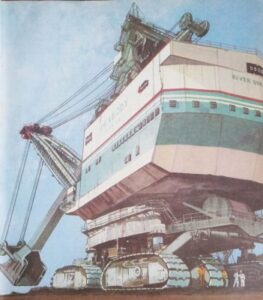The Moon, Earth’s closest celestial neighbor, has fascinated humans for millennia. As we stand on the brink of potential lunar colonization, one resource emerges as pivotal to building a sustainable future on the Moon: lunar regolith.

Image by SciTechDaily
Table of Contents
Understanding Lunar Regolith
Lunar regolith, the Moon’s soil or lunar soil, comprises a mix of fine dust and rocky debris covering the surface. Resulting from billions of years of meteorite impacts, it holds essential clues to the Moon’s geological history and is a primary material for future lunar construction.
Source of Oxygen
Regolith contains significant amounts of oxygen, bound in minerals. Processes are being developed to extract this oxygen, vital for life support systems and as a component in rocket fuel, supporting longer missions and potential permanent settlements.
Solar Panel Production
Silicon, an important component for solar panels, can be extracted from lunar regolith. This ability could facilitate the production of solar panels on the Moon, powering future colonies.
3D Printing Material
Scientists are exploring using lunar regolith as a raw material for 3D printing, allowing construction of habitats and other structures directly on the Moon’s surface, reducing the need to transport materials from Earth.
Protection Against Radiation
The Moon’s lack of atmosphere exposes it to cosmic radiation. Regolith can be used to build protective shelters, greatly reducing radiation exposure for inhabitants.
Thermal Insulation
Regolith has excellent thermal properties, helping to maintain stable temperatures inside lunar habitats by insulating against the Moon’s extreme temperature fluctuations.
Growing Agricultural Crops
Research indicates that plants can be grown in lunar regolith, once it is appropriately processed. This is a crucial step towards self-sustaining lunar colonies.
Manufacturing of Glass and Ceramics
Lunar regolith contains minerals that can be processed into glass and ceramics, essential for various construction and manufacturing processes.
Pathway Construction
Regolith’s compactibility makes it ideal for constructing pathways and foundations, essential for infrastructure development on the Moon.
Water Extraction
Recent discoveries suggest that water ice may be mixed within the lunar soil, particularly in permanently shadowed regions. Extracting this water would be critical for life support and fuel.
Research and Development
Lunar regolith offers a unique opportunity for scientific research, including studies on its formation, the history of our solar system, and the feasibility of using in-situ resources for habitation.
Economic Opportunities
The ability to utilize lunar regolith opens up numerous economic opportunities, from mining and construction to tourism and scientific exploration, laying the foundation for a new lunar economy.
Lunar regolith is not just Moon dust; it is a cornerstone upon which the future of lunar exploration and colonization could be built. With its diverse applications, from building materials to life support, leveraging this off-world resource could significantly accelerate humanity’s efforts to establish a sustainable presence on the Moon.

Image by ScienceDirect.com
How can we mitigate the abrasive nature of lunar regolith for machinery and astronaut safety?
Mitigating the abrasive nature of lunar regolith is crucial for the safety and longevity of machinery and astronaut gear due to its fine, sharp characteristics that can cause significant wear and damage. Here are strategies to address this challenge:
- Material Selection and Coating: Use materials and coatings that are resistant to abrasion for all equipment and suits. Aerospace-grade materials, such as certain alloys or ceramics, can offer enhanced resistance. Coatings might include diamond-like carbon or other advanced compounds designed to reduce friction and wear.
- Sealant Technologies: Improve sealant technologies to prevent regolith particles from entering machinery and equipment. Magnetic seals or electrostatic repulsion methods could offer innovative solutions to keep the fine particles at bay.
- Dust-Tolerant Designs: Rethink the design of mechanical parts to minimize spaces where regolith can accumulate or cause jamming. Smooth surfaces and minimized gaps can reduce the amount of dust that settles on and in machinery.
- Regular Maintenance and Cleaning: Implement procedures for regular maintenance and cleaning of equipment to remove regolith particles. This can include brushes, blowers, or even electrostatic cleaning methods that help keep surfaces clean without direct contact.
- Protective Suits: Engineer more robust and regolith-resistant fabrics for spacesuits that can withstand the abrasive environment. Such fabrics need to maintain flexibility while offering protection, possibly through advanced weaving techniques or surface treatments that repel dust.
- Lunar Infrastructure: Design infrastructure that limits exposure of equipment and astronauts to loose regolith, such as creating smooth launchpads or paths made from sintered or otherwise treated regolith, reducing direct contact with abrasive particles.
- Regolith Management Methods: Research and develop approaches for managing regolith in operational areas, including using electromagnetic fields to contain or repel lunar dust away from critical equipment and habitation areas.
By incorporating these methods, we can significantly reduce the impact of lunar regolith’s abrasive nature on machinery and astronaut gear, enhancing the safety and success of lunar missions.
The Enduring Legacy of the First Steps: Lunar Regolith and the Preservation of History

Image by ResearchGate
Since the monumental moment on July 20, 1969, when Neil Armstrong and Buzz Aldrin first set foot on the moon, their iconic footprints have remained virtually unchanged, embedded in the lunar surface. This remarkable preservation is not merely a tribute to human achievement but also highlights the unique properties of lunar regolith. Unlike Earth, the moon lacks an atmosphere and, subsequently, the weathering processes that erode and reform landscapes over time. This absence of weathering effects on the moon ensures the longevity of surface features, making the lunar regolith an invaluable record of the past.
Lunar regolith is composed of fine rock particles and dust, formed over billions of years by the constant bombardment of meteorites and the sun’s intense radiation. This environment, devoid of water, air, and organic life, means that the footprints of Armstrong and Aldrin, along with other artifacts left by the Apollo missions, remain as they were, untouched and unaltered. The regolith’s stability offers a pristine snapshot of history, making it more than just soil—it’s a canvas that captures a seminal moment in human exploration.
The preservation of these footprints does more than mark a historic milestone; it showcases the importance of lunar regolith in the broader context of lunar exploration. Scientists study the properties of regolith to understand the moon’s geology, history, and potential for future missions. For instance, learning about its composition aids in the development of technology for habitat construction, life support systems, and resource extraction, which are crucial for long-term lunar habitation and exploration.
The regolith’s ability to protect these footprints from the harsh environment of space also provides insights into how lunar bases might shield astronauts from cosmic radiation and micrometeorite impacts. Its lessons guide us in developing materials and structures that can withstand the moon’s extreme conditions.
The enduring footprints of Armstrong and Aldrin serve as a testament to the lunar regolith’s unique properties and its significance in the ongoing quest for knowledge and exploration. As we continue to gaze upon these unchanged symbols of human achievement, they not only remind us of what was accomplished but also inspire us to consider what remains to be discovered on the moon and beyond.
Overcoming Lunar Settlement Challenges with Lunar Regolith
Setting up permanent bases on the moon presents an array of formidable challenges that demand innovative solutions. Among the most significant hurdles are the transportation of materials over vast distances from Earth and the indispensable need for on-site resource utilization to ensure sustainability. In the quest to establish a long-term human presence on the lunar surface, lunar regolith, the layer of loose, fragmented material covering solid rock, emerges as a primary resource for mitigating these challenges.
The transportation of construction materials from Earth to the Moon poses considerable logistical and economic problems. Each kilogram of payload launched into space entails a hefty cost, making the shipment of large quantities of building materials impractical. Here, lunar regolith offers a groundbreaking solution. Comprised mainly of small particles formed by the constant bombardment of the lunar surface by meteoroids and the sun’s ultraviolet radiation, this material is available in abundance across the Moon. By leveraging this readily available resource, we can significantly reduce our reliance on Earth-bound supplies.
The versatility of lunar regolith makes it an invaluable asset for various construction purposes. Scientists and engineers are exploring techniques such as sintering and 3D printing with regolith-based materials to construct habitable structures, shielding, and infrastructure. These innovations aim to utilize the regolith not just as a building material but also as a component in the production of essential elements like oxygen, hydrogen, and even water, which can be extracted from its mineral content.
The use of regolith extends beyond construction. Its potential in providing radiation shielding is particularly promising. The Moon’s lack of atmosphere exposes surfaces and inhabitants to space radiation; however, structures built with thick regolith walls could offer the necessary protection, enabling safer long-term habitation.
The transformation of lunar regolith from a ubiquitous layer of dust to a cornerstone of lunar colonization illustrates a shift toward sustainable space exploration. By using in-situ resources, we are developing the capabilities needed for humanity’s expansion into the solar system. The utilization of lunar regolith stands not just as a testament to human ingenuity but as a pivotal strategy in overcoming the challenges of establishing permanent bases on the Moon.
FAQs
Lunar regolith is a layer of loose, fragmented material covering solid rock on the Moon’s surface. It consists of dust, soil, broken rock, and related materials, formed over billions of years by the continuous bombardment of micrometeoroids and the harsh solar wind. This layer varies in thickness from a few meters to potentially tens of meters, depending on the location on the Moon.
The formation of lunar regolith is primarily the result of space weathering processes. These include the impact of micrometeorites, exposure to cosmic rays, solar wind bombardment, and the occasional meteorite impact. These processes break down the bedrock and fuse some of the materials together, creating the fine dust and jagged fragments characteristic of the lunar soil.
Lunar regolith is significant for several reasons. Its abundance makes it a readily available resource for construction materials, shielding against radiation, and potentially for extracting oxygen for life support. Using regolith as a building material could significantly reduce the need and cost of transporting materials from Earth. Innovations like 3D printing with regolith-based “ink” are being explored to construct habitats and other structures on the Moon.
Yes, lunar regolith holds potential for sustaining life on the Moon. Research suggests that lunar soil contains components like oxygen, which can be extracted for breathing. Moreover, it may support plant growth in controlled environments, which is essential for long-term sustainability of lunar habitats. The regolith can also provide material for manufacturing solar panels, supporting the production of energy.
Lunar regolith can be transformed into various construction materials, including bricks, paving stones, and even a form of concrete. Techniques are being developed to sinter or melt the regolith using solar energy or microwaves, creating solid structures for building bases, landing pads, roads, and shelters. This utilization of in-situ resources could greatly facilitate lunar colonization by providing cost-effective, robust materials for construction and infrastructure development.






























